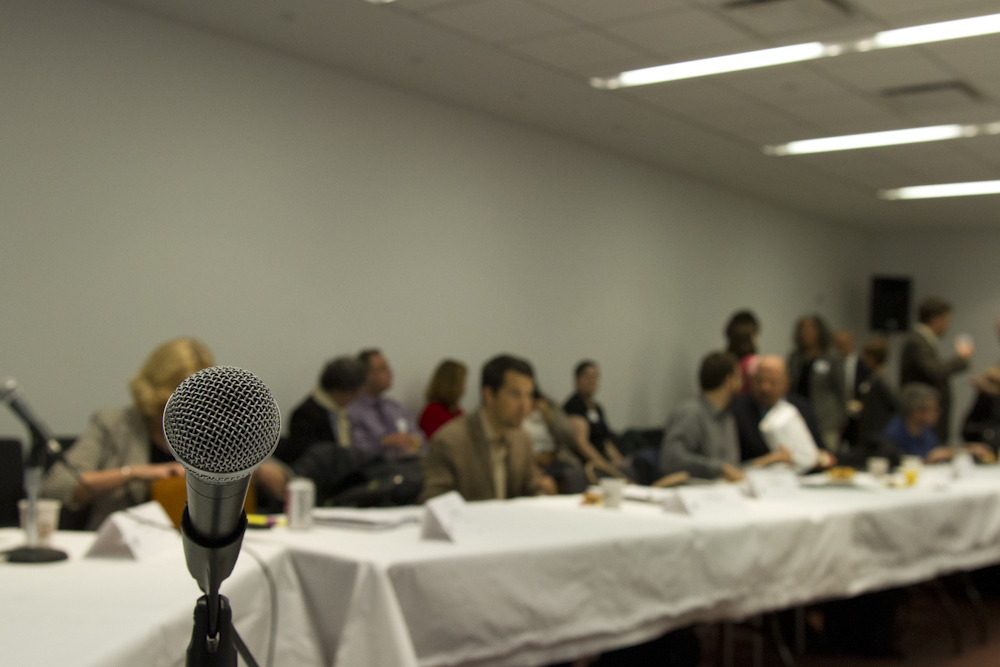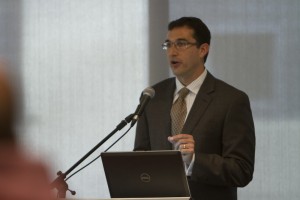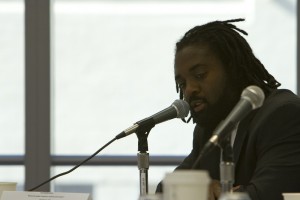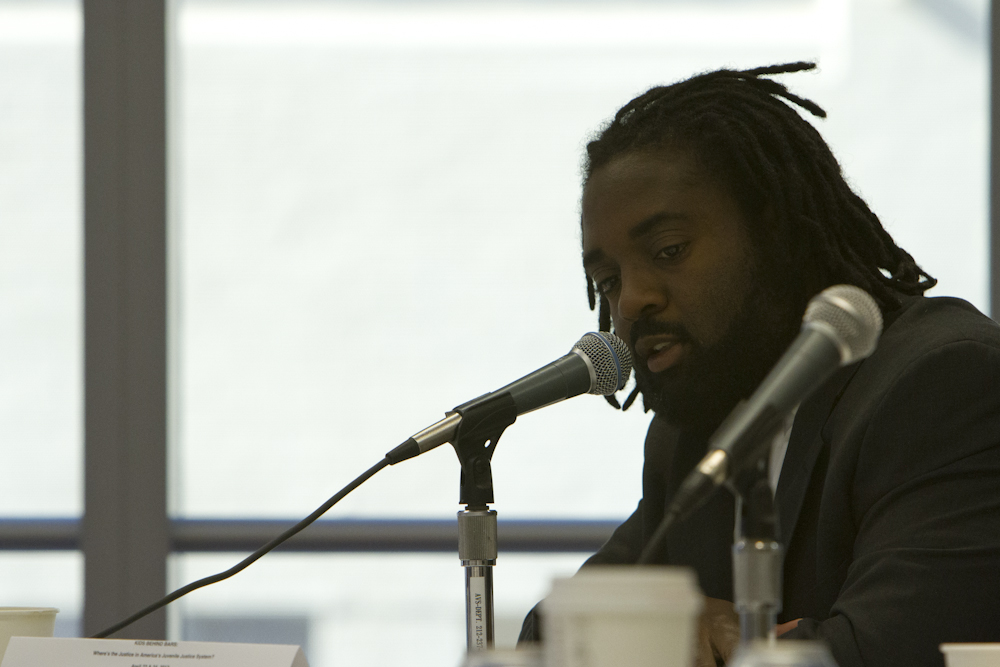
NEW YORK – The John Jay College of Criminal Justice’s Center on Media, Crime and Justice is holding a two-day conference for journalists on its campus in New York Monday and Tuesday.
While the conference, Kids Behind Bars, Where’s the Justice in America’s Juvenile Justice System?, is primarily meant for journalists, many of the topics will be of interest not only to those in the field, but the general public as well.
JJIE/Youth Today’s John Fleming and Clay Duda are attending the conference and continue their reporting today. For Day One coverage head over to our post here.
DAY TWO
Panel One:

Mike Bocain
Mike Bocian, provided the keynote address Tuesday morning. Bocian, is a founding partner at GBA Strategies, a public opinion research firm.
Bocian discussed recent findings showing that most of those polled accepted that young offenders could change and that there was widespread support among those polled for prevention and rehabilitation. He also pointed out that those polled seem to be much more willing to favor rehabilitation and prevention when it was clear the subject of the poll was juveniles.
The overwhelming majority of those polled felt that youth who committed both violent and non-violent crimes should be housed with other youth, not adults.
The public, Bocian said, cited public safety and reducing recidivism as the best reasons for juvenile justice reform. For the most part, however, they did not mention budgetary concerns as reasons for change. He noted, however, that many reform measures currently being undertaken are being driven by budgetary concerns.
More than 50 percent of those polled said they found former youth offenders one of the most trustworthy experts on juvenile justice issues. They were found to be more trustworthy than experts such as juvenile judges and prosecutors.
Bocian also spoke about the importance of language. He pointed out, for example, that 42 percent of those polled saw “juvenile” as a negative term, while 37 percent saw the word “youth” as a positive term.
Liz Ryan, the president of the Campaign for Youth Justice and R. Dwayne Betts, an author, commentator and former youth offender, discussed Bocian’s findings.

Liz Ryan
Ryan stressed to the journalists and policy experts assembled the importance of understanding how many young people are brought into the criminal justice system each year.
Some 250,000 children are prosecuted in adult criminal court each year, she said. She also pointed out that not just a handful of states, but every state tries kids as adults. “It is wrong when you hear that not many kids are tried as adults each year,” she said.
Ryan said that many people will say that kids are locked up for a reason and that they must have done something wrong. Yet, she insists, this is often wrong; often kids are tried for relatively minor offenses and there are many instances when young people are locked up and have not even been charged.
Ryan also pointed out that juvenile crime is actually going down, not up, but that juvenile violent crime is not going down because more people are being locked up.
Dwayne Betts spoke of his time in prison and his journey through life since his release.

Dwayne Betts
Referring to the poll’s findings, Betts said while he found it encouraging, it still reminds him that young people in the system are invisible.
Youth in prison have been ignored for decades, he said.
He pointed out that he was locked up for car jacking when he was 16 and is 31 today. He was tried as an adult and served eight years in prison.
One of his cellmates was serving a 63-year-sentence for a non-homcidal offense he committed at age 16.
Betts said that his first 10 days in detention were spent in solitary confinement. He had no mattress, he said, no pillow and no sheets. A brutal introduction, he said, to confinement.
Betts reminded the audience that people who go to prison are more than the statistics they represent.
“I was treated as a number from the beginning,” he said. “I was an honors student, but the prosecutor never saw that. The judge admitted to me, in front of my mother and my family, that he was under no illusion that prison would help me.”
Betts went on to obtain undergraduate and graduate degrees at the University of Maryland, authored A Question of Freedom, a memoir, was awarded a Soros Fellowship and is currently a Radcliffe Fellow at Harvard.
Panel Two:
Judge Steve Teske, a juvenile court judge from Clayton County, Ga., and a frequent contributor to the Juvenile Justice Information Exchange, moderated a panel on the so-called school-to-prison pipeline.
Others on the panel included: Nancy Heitzeg, a professor of sociology & co-director of Critical Studies of Race/Ethnicity at St. Catherine University; Elton Anglada of the Juvenile Defender’s Association of Pennsylvania and Joseph Gaudett, the chief of police of Bridgeport, Conn.
Professor Heitzeg explained that the school-to-prison pipeline is essentially a growing trend that involves tracking kids out of school and into the criminal justice system. There are, she argues, several reasons for this growing trend, including the re-segregation of schools, growing poverty rates, the over representation of kids of color in special education classes, the underrepresentation of kids in advanced classes and zero tolerance policies.
She said that zero tolerance policies being implemented in schools have increased, while at the same time, violence in schools has fallen across the nation.
Zero tolerance policies have resulted in some three million suspensions and 100,000 expulsions per year.
Heitzeg said there is a blurring of the lines between the educational and judicial systems. With police in the school and drug-sniffing dogs in the hallways, she asked, “how likely is it that you are going to go to school if school continually resembles jail?”
She also pointed out that racial disparity is the biggest issue in the school-to-prison pipeline. Endless studies, she said, show that African-American students are punished at much higher rates than non-minority students, though studies also show that white youth engage in the same kind of disruptive behavior at a similar rate.
She cautioned the assembled journalists that while the individual story may be compelling, that it is important to explain the larger context of the school-to-prison pipeline. It does not exist in a vacuum, she said. It is complicated, and it is about deeply entrenched racial stereotypes.
In a question and answer session, Chief Gaudett, talked about his department’s philosophy in dealing with children. He said his officers are trained to engage with children in an attempt to humanize the officer and to build trust with the kids.
After a lively discussion with Teske, almost a courtroom exchange, Anglada spoke about the lack of due process in public schools.
He pointed out that when a child is arrested in school, the kid is expelled or suspended without legal representation, that he or she is already thrown out of the school without due process.
He also spoke of the reality of family court. It is a place that is seen by many as “kiddy court,” it is not, he said, “taken seriously. It is where many attorneys cut their teeth. It’s not a bad idea, it is good experience, but it is not good for juveniles.”
He added that juvenile court is incentivized to plea kids out. It pays low-paid attorneys more, he said, to plea than to carry the case forward.
Anglada spoke at length about a recent scandal in Luzerne County, Pa., that involved kickbacks paid to juvenile judges in exchange for sending juveniles to detention.
It was, he said, a big and important story. But it only became a story after the judges in the case were indicted. When it became “Kids for Cash,” Anglada said, it was a big story. But few though it was a story when his organization was trying to get anyone’s attention, including the state’s Supreme Court, to the fact that some 7,000 kids had gone through juvenile court in Luzerne County without legal representation.
“Why wasn’t ‘7,000 kids without an attorney’ not a story?” he asked.
For Day One coverage head over to our post here.
Photos by Clay Duda | JJIE.org
